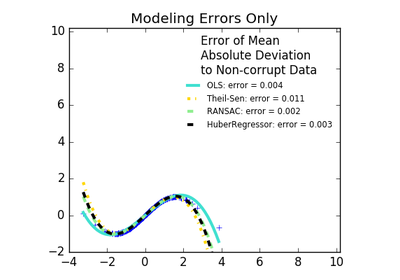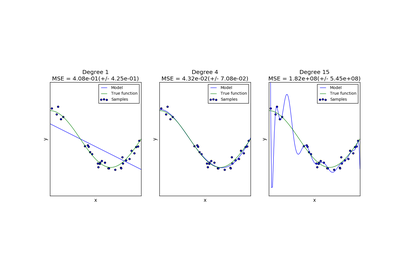sklearn.preprocessing.PolynomialFeatures¶
-
class
sklearn.preprocessing.PolynomialFeatures(degree=2, interaction_only=False, include_bias=True)[source]¶ Generate polynomial and interaction features.
Generate a new feature matrix consisting of all polynomial combinations of the features with degree less than or equal to the specified degree. For example, if an input sample is two dimensional and of the form [a, b], the degree-2 polynomial features are [1, a, b, a^2, ab, b^2].
Parameters: degree : integer
The degree of the polynomial features. Default = 2.
interaction_only : boolean, default = False
If true, only interaction features are produced: features that are products of at most
degreedistinct input features (so notx[1] ** 2,x[0] * x[2] ** 3, etc.).include_bias : boolean
If True (default), then include a bias column, the feature in which all polynomial powers are zero (i.e. a column of ones - acts as an intercept term in a linear model).
Attributes: powers_ : array, shape (n_output_features, n_input_features)
powers_[i, j] is the exponent of the jth input in the ith output.
n_input_features_ : int
The total number of input features.
n_output_features_ : int
The total number of polynomial output features. The number of output features is computed by iterating over all suitably sized combinations of input features.
Notes
Be aware that the number of features in the output array scales polynomially in the number of features of the input array, and exponentially in the degree. High degrees can cause overfitting.
See examples/linear_model/plot_polynomial_interpolation.py
Examples
>>> X = np.arange(6).reshape(3, 2) >>> X array([[0, 1], [2, 3], [4, 5]]) >>> poly = PolynomialFeatures(2) >>> poly.fit_transform(X) array([[ 1., 0., 1., 0., 0., 1.], [ 1., 2., 3., 4., 6., 9.], [ 1., 4., 5., 16., 20., 25.]]) >>> poly = PolynomialFeatures(interaction_only=True) >>> poly.fit_transform(X) array([[ 1., 0., 1., 0.], [ 1., 2., 3., 6.], [ 1., 4., 5., 20.]])
Methods
fit(X[, y])Compute number of output features. fit_transform(X[, y])Fit to data, then transform it. get_feature_names([input_features])Return feature names for output features get_params([deep])Get parameters for this estimator. set_params(\*\*params)Set the parameters of this estimator. transform(X[, y])Transform data to polynomial features -
fit_transform(X, y=None, **fit_params)[source]¶ Fit to data, then transform it.
Fits transformer to X and y with optional parameters fit_params and returns a transformed version of X.
Parameters: X : numpy array of shape [n_samples, n_features]
Training set.
y : numpy array of shape [n_samples]
Target values.
Returns: X_new : numpy array of shape [n_samples, n_features_new]
Transformed array.
-
get_feature_names(input_features=None)[source]¶ Return feature names for output features
Parameters: input_features : list of string, length n_features, optional
String names for input features if available. By default, “x0”, “x1”, ... “xn_features” is used.
Returns: output_feature_names : list of string, length n_output_features
-
get_params(deep=True)[source]¶ Get parameters for this estimator.
Parameters: deep : boolean, optional
If True, will return the parameters for this estimator and contained subobjects that are estimators.
Returns: params : mapping of string to any
Parameter names mapped to their values.
-
set_params(**params)[source]¶ Set the parameters of this estimator.
The method works on simple estimators as well as on nested objects (such as pipelines). The latter have parameters of the form
<component>__<parameter>so that it’s possible to update each component of a nested object.Returns: self :
-
transform(X, y=None)[source]¶ Transform data to polynomial features
Parameters: X : array-like, shape [n_samples, n_features]
The data to transform, row by row.
Returns: XP : np.ndarray shape [n_samples, NP]
The matrix of features, where NP is the number of polynomial features generated from the combination of inputs.
-




